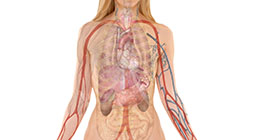
Over 90 percent of hysterectomies are unnecessary. Only 10 percent of hysterectomies are deemed medically necessary.Unsuccessful conventional treatments for many common perimenopausal conditions such as heavy periods, endometrioses, uterine fibroids or prolapsed uterus put women at risk for a hysterectomy, and we feel it is important to present some information about them.
A report prepared by the Ontario Women’s Health Council says that Canadian women are having hysterectomies too frequently as a first line of treatment for discretionary reasons—to supposedly improve a woman’s quality of life—rather than to save her life. The report found that hysterectomy remains the most common procedure used to treat non-life-threatening conditions such as abnormal uterine bleeding (heavy periods), uterine fibroids, endometriosis, unexplained pelvic pain, and prolapsed uterus. And the same holds true for American women.
Just turning 40 years old in North America puts women at risk of losing their uterus. Women aged 40 to 44 years had a significantly higher rate of hysterectomy, at 11.7 per 1,000, than any other age group in the study. Fifty-two percent of all hysterectomies are performed on women younger than 44 years of age. With the population’s aging baby boomers, hysterectomy rates are only going to climb. The highest hysterectomy rate, 16.8 per 1,000, is in African American women aged 40 to 44 years.
Abdominal hysterectomies were performed more frequently than vaginal hysterectomies in all races. Hysterectomy rates are more than twice as high in northern and rural areas than in metropolitan centers that have teaching hospitals. Over 55 percent of hysterectomies also involve the removal of both ovaries, which immediately throws a woman into surgical menopause.
Female Castration
Dr. Stanley West, M.D., author of The Hysterectomy Hoax, states that “removal of the ovaries is castration. A man would never consent to having his testicles removed unless he had cancer or some other life-threatening condition, yet women have their ovaries removed in record numbers simply because doctors are not telling them they will be castrated.”
If physicians started to adopt the terminology of castration and disclosed the potential side effects of hysterectomy, most women would refuse to undergo the procedure and seek alternatives. It is important to understand how a hysterectomy may affect overall health, hormone balance, and especially the ability to have and enjoy sex afterwards.
Facts About Hysterectomy
- The word hysterectomy comes from the Greek word hystra, which means suffering caused by the uterus.
- Hysterectomy is the removal of the uterus.
- Oophorectomy is the removal of one or both ovaries.
- A complete hysterectomy is the removal of both the ovaries and the uterus.
- Supracervical hysterectomy leaves the cervix in place, which leaves the vagina longer with less discomfort during intercourse.
- Laparoscopic-assisted vaginal hysterectomy involves using a laparoscope to remove the uterus and/or ovaries.
Potential Side Effects of Hysterectomy
Although many women report that they feel better after a hysterectomy, others are not so lucky. Vaginal, abdominal, and laparoscopic hysterectomies are each performed with their own inherent risks. The reported side effects may include:
- Adhesions: Adhesions are bands of tough, fibrous, scar-like tissue that can occur during injury or surgery. These adhesions can interfere with normal functioning of an organ. Pelvic adhesions, where organs bind together, can occur on the bladder and bowel, especially if the woman has endometriosis. During a vaginal hysterectomy, the surgeon’s ability to see these adhesions may be impaired. If this happens, a woman who thought she was going to have a vaginal hysterectomy may end up with an abdominal hysterectomy.
- Bowel injury: If the bowel is accidentally cut, infection can occur, or a fistula (an opening between the rectum and vagina that allows fecal material to enter the vagina) can develop. This can be repaired during surgery, if the surgeon is aware that a cut has been made.
- Bladder injury: Infection from a cut to the bladder can occur; or a fistula between the bladder and vagina can occur, allowing urine to leak into the vagina. Again, this can be repaired during a hysterectomy if the surgeon notes the problem. This does not always happen but many women report incontinence and bladder frequency issues after hysterectomy.
- Ureter injury: The ureter is next to the cervix; it is the tube connecting the kidney to the bladder. It can be easily bruised, nicked, or otherwise injured, causing urinary tract problems.
- Ovarian failure: If the ovarian blood supply is damaged the ovaries may eventually fail after a hysterectomy. This ovarian failure following hysterectomy is seen in 15-50 percent of the cases. This is caused by impairment of ovarian vascular supply or by the loss of some important endocrine contribution by the uterus to the ovary. At surgery, effort must be made to preserve all normal ovarian tissue and prevent damage to the ovarian blood supply.
- Sexual dysfunction: Many women report never having another orgasm once they have had a hysterectomy due to important nerves being cut during the operation; others report sad feelings related to a perceived decrease or loss of their sexuality. The uterus and ovaries are a large part of what makes us female, and many women grieve the loss of their organs. (Back in the nineteenth century, hysterectomy was used as a treatment to stop perceived sexual perversions such as masturbation and promiscuity.)
- Depression and Low Libido: Estrogen acts to stimulate the release of endorphins from the hypothalamus. Removal of the ovaries (a major estrogen source) in some women has a profound effect on hormones related to happiness, resulting in mood swings and depression. The ovaries are also a source of testosterone, which promotes higher energy, vitality, and a desire for sex.
- Estrogen-deficiency symptoms: Vaginal dryness, incontinence, painful intercourse, severe hot flashes, night sweats, joint pain, heart palpitations, anxiety, and depression are reported.
- Shortened vagina: A technique called Worrelling (named after Dr. Worrell) can be used to peel the vagina away from the cervix and maintain the length of the vagina. Without this technique, many women are left with a shortened vagina and painful intercourse. Even with this technique, women have painful intercourse.
- Weight gain: Many women report a large weight gain after hysterectomy.
Think Twice About Hysterectomy
Dr. Laura Berman, Ph.D., author of The Passion Prescription states that “any surgery performed for gynecological conditions can challenge a woman’s sexual wellbeing. The medical field still does not know where all of the important nerves and blood vessels are situated in a woman’s pelvis. As a result, many are inadvertently damaged during pelvic surgeries, which can pose a real problem for sexual response. Severed nerves and blood vessels compromise lubrication, sensation, and feelings of fullness in the genital area when you are aroused.”
Some conditions require a hysterectomy due to cancer or another medically necessary reason. For all other women, use the safe, effective alternatives to hysterectomy for conditions covered in our conditions section.










